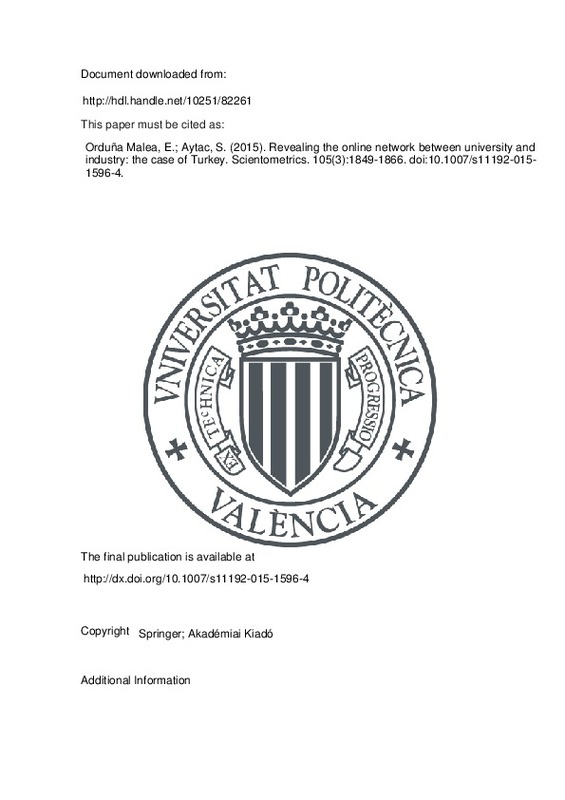Aguillo, I. F., Granadino, B., Ortega, J. L., & Prieto, J. A. (2006). Scientific research activity and communication measured with cybermetrics indicators. Journal of the American Society for Information Science and Technology, 57(10), 1296–1302.
Arslan, M. L., & Seker, S. E. (2014). Web based reputation index of Turkish Universities. International Journal of E-Education E-Business E-Management and E-Learning, 4(3), 197–203.
Aytac, S. (2010). International scholarly collaboration in science, technology and medicine and social science of Turkish scientists. The International Information & Library Review, 42(4), 227–241.
[+]
Aguillo, I. F., Granadino, B., Ortega, J. L., & Prieto, J. A. (2006). Scientific research activity and communication measured with cybermetrics indicators. Journal of the American Society for Information Science and Technology, 57(10), 1296–1302.
Arslan, M. L., & Seker, S. E. (2014). Web based reputation index of Turkish Universities. International Journal of E-Education E-Business E-Management and E-Learning, 4(3), 197–203.
Aytac, S. (2010). International scholarly collaboration in science, technology and medicine and social science of Turkish scientists. The International Information & Library Review, 42(4), 227–241.
Bahçıvan, E. (ed.) (2013). Turkey’s Top 500 Industrial enterprises 2012. The Journal of the Istanbul Chamber of Industry, 48(569), 1–124 (special issue).
Barabasi, A. L., & Albert, R. (1999). Emergence of Scaling in Random Networks. Science, 286(5439), 509–512.
Cankir, B., Arslan, M. L., & Seker, S. E. (2015). Web Reputation Index for XU030 Quote Companies. Journal of Industrial and Intelligent Information, 3(2), 110–113.
Faba-Fernández, C., Guerrero-Bote, Vicente P., & Moya-Anegón, F. (2003). Data mining in a closed web environment. Scientometrics, 58(3), 623–640.
Fruchterman, T. M., & Reingold, E. M. (1991). Graph drawing by force‐directed placement. Software: Practice and experience, 21(11), 1129–1164.
García-Santiago, L., & De Moya-Anegón, F. (2009). Using co-outlinks to mine heterogeneous networks. Scientometrics, 79(3), 681–702.
Jolliffe, I. (2002). Principal component analysis. New York: Springer.
Khan, G. F., & Park, H. W. (2011). Measuring the triple helix on the web: Longitudinal trends in the university–industry–government relationship in Korea. Journal of the American Society for Information Science and Technology, 62(12), 2443–2455.
Leydesdorff, L., & Etzkowitz, H. (1996). Emergence of a triple helix of university–industry–government relations. Science and public policy, 23(5), 279–286.
Leydesdorff, L., & Park, H. W. (2014). Can synergy in triple-helix relations be quantified? A review of the development of the triple-helix indicator. arXiv preprint arXiv:1401.2342.
Meyer, M. (2000). What is special about patent citations? Differences between scientific and patent citations. Scientometrics, 49(1), 93–123.
Meyer, M., Siniläinen, T., & Utecht, J. T. (2003). Towards hybrid triple helix indicators: A study of university-related patents and a survey of academic inventors. Scientometrics, 58(2), 321–350.
Minguillo, D., & Thelwall, M. (2012). Mapping the network structure of science parks: An exploratory study of cross-sectoral interactions reflected on the web. Aslib Proceedings, 64(4), 332–357.
Montesinos, P., Carot, J. M., Martínez, J. M., & Mora, F. (2008). Third mission ranking for world class universities: Beyond teaching and research. Higher Education in Europe, 33(2/3), 259–271.
Orduna-Malea, E., & López-Cózar, E. D. (2014). Google scholar metrics evolution: An analysis according to languages. Scientometrics, 98(3), 2353–2367.
Ortega, J. L., Orduna-Malea, E., & Aguillo, I. F. (2014). Are web mentions accurate substitutes for inlinks for Spanish universities? Online Information Review, 38(1), 59–77.
Priem, J., & Hemminger, B. H. (2010). Scientometrics 2.0: New metrics of scholarly impact on the social Web. First Monday, 15(7). http://firstmonday.org/ojs/index.php/fm/article/viewArticle/2874 . Accessed 31 December 2014.
Romero-Frías, E. (2011). Googling companies-a webometric approach to business studies. Leading Issues in Business Research Methods, 7(1), 93–106.
Romero-Frías, E., & Vaughan, L. (2010). Patterns of web linking to heterogeneous groups of companies: The case of stock exchange indexes. Aslib Proceedings, 62(2), 144–164.
Stuart, D., & Thelwall, M. (2006). Investigating triple helix relationships using URL citations: A case study of the UK West Midlands automobile industry. Research Evaluation, 15(2), 97–106.
Thelwall, M. (2004). Link analysis: An information science approach. San Diego: Academic Press.
Thelwall, M. (2014). A brief history of altmetrics. Research trends, 37, 3–4. http://www.researchtrends.com/issue-37-june-2014/a-brief-history-of-altmetrics/ . Accessed 31 December 2014.
Thelwall, M., & Harries, G. (2003). The connection between the research of a university and counts of links to its Web pages: An investigation based upon a classification of the relationships of pages to the research of the host university. Journal of the American Society for Information Science and Technology, 54(7), 594–602.
Vaughan, L. (2004). Exploring website features for business information. Scientometrics, 61(3), 467–477.
Vaughan, L. (2006). Visualizing linguistic and cultural differences using Web co-link data. Journal of the American Society for Information Science and Technology, 57(9), 1178–1193.
Vaughan, L., & Yang, R. (2012). Web data as academic and business quality estimates: A comparison of three data sources. Journal of the American Society for Information Science and Technology, 63(10), 1960–1972.
Vaughan, L., Gao, Y., & Kipp, M. (2006). Why are hyperlinks to business Websites created? A content analysis. Scientometrics, 67(2), 291–300.
Vaughan, L., & Romero-Frías, E. (2012). Exploring web keyword analysis as an alternative to link analysis: A multi-industry case. Scientometrics, 93(1), 217–232.
Vaughan, L., & Thelwall, M. (2003). Scholarly use of the web: What are the key inducers of links to journal web sites? Journal of the American Society for Information Science and Technology, 54(1), 29–38.
Vaughan, L., & Wu, G. (2004). Links to commercial web sites as a source of business information. Scientometrics, 60(3), 487–496.
Wilkinson, D., & Thelwall, M. (2013). Search markets and search results: The case of Bing. Library & Information Science Research, 35(4), 318–325.
[-]







![[Cerrado]](/themes/UPV/images/candado.png)


